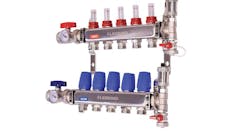Latest from AHR
Sponsored
AHR 2019 Session: Benefits of Manifold Flow Meters
ATLANTA, GA — Bill Werthman introduced his session, "Benefits of Manifold Flow Meters," by saying he was a reluctant plumber. It was the opportunity to learn about and work with new technology that drew him in. "I wanted to learn as much as I could about the industry -- I wanted to learn it all."
Eventually that led him to Legend Valves where he began a distinguished career of what he refers to as "breaking stuff for a living." Werthman would torment engineers by dropping valves, abusing them with Channelocks, installing them backwards... on and on. And Legend came to appreciate his contributions so much that they made him Senior Technical Advisor.
For his session -- sponsored by Women in HVACR and the Radiant Professionals Alliance -- Werthman discussed basic problems in the design of radiant hydronic heating systems. Werthman fell in love with radiant heating early in his career (he cites "Pumping Away" by industry legend Dan Holohan as the book that really sparked his interest).
The first step in any radiant system design is to estimate the load calculation. In the old days many installers used the rules of thumb to get a fairly good approximation. Nowadays, design software can get a contractor much more accurate numbers to work with. Rather than over-designing the system, the new software allows home/building owners to save a little money on their heating bills.
Distribution
One of the most basic problem is ensuring even heat throughout a radiant installation. For a lot of "old timers," the simplest solution to the problem is just to have each loop coming off the manifold be the same length. Unfortunately, this will not always guarantee even heating.
There are a lot of different manifolds out on the market. Most contractors make their choice based on price and availability. Even a simple copper manifold can work well for many jobs. But be aware once you start building a manifold in the shop, adding all the isolation valves can start to add up in time and money, to the point where simply buying a manifold just makes more sense.
When an entire system is trying to satisfy for the coldest room's heat loss, you are almost invariably going to end up with some rooms that are overheated.
Another problem: all the tail ends of your loops end up in the same mechanical room, which will soon overheat, wasting Btus.
Ideally, each room/space of an installation should have its own loop. Now all the loop lengths are unequal; you can't just plug all the ends into a copper manifold and hope to have the system balance.
Flow meters to the rescue
The solution? Flow meters, creating a different, appropriate GPM for each loop of the system. With flow meters each room is supplied with its own circuit. It allows the installer to turn different rooms on and off, which is helpful both for saving energy (just turn off those rooms no one is occupying) and for troubleshooting problems in the system, not to mention commissioning.
Loop tails will still cause a lot of wasted heat. One possible solution is to remote locate manifolds in places that make the most sense.
Flow meters will work in any position, even upside-down (although you might need to flip your air release).
There are many manifolds on the market with built-in flow meters, and they are not that much more expensive.
Final thoughts
Keep in mind that just because you have a balanced loop does not mean you have a balanced system.
Some software programs to help design a good radiant hydronic system include Wrightsoft (although Werthman feels it uses a lot of extra data points that most people do not need) and LoopCAD.
And lastly, an accurate design does not mean an accurate installation. Some installers will sometimes flat-out ignore parts of a design that make no sense to them. Proper follow-up and system testing is always needed to ensure that the final system performs as expected.
Steve Spaulding | Editor-inChief - CONTRACTOR
Steve Spaulding is Editor-in-Chief for CONTRACTOR Magazine. He has been with the magazine since 1996, and has contributed to Radiant Living, NATE Magazine, and other Endeavor Media properties.


